Five Pillars
Teachings you can count on one hand
Two hundred years after the Buddha’s death, a flourishing Buddhist society was taking root in South India in what is now Andhra Pradesh. Their temples, such as Amaravati, did not then feature Buddha statues, but along with stupas and stone carvings, which have shaped the trajectory of Indian art to this day, were pillars in groups of five—some of which are still being unearthed nearly a millennium after Buddhism’s decline began across India. Five lines too could be found carved into many features of these temples.
It has been suggested that the symbolism relates to either the Five Buddhas of Buddhist mythology or the five important events in the life of the Buddha: birth, renunciation, enlightenment, first sermon and death.
Buddhadasa Bhikkhu, however, found them to be valuable reminders of some of the most important pillars of what the Buddha actually taught, so much so that he had pillars erected on the tops of buildings and gates at Suan Mokkh in Chaya.
“The five pillars on our roofs are symbolic of the five hindrances (nīvaraṇa), the five groups of clinging (upādānakkhandha), the five powers (bala), the five sovereigns (indriya), the five essentials (dhammasāra), the five paths & fruits & nibbāna (magga-phalanibbāna). Even the five fingers on your own hand are just reminders of the matter of eliminating dukkha for us all.”
Spanning the base of these pillars at BIA is a replica of one of the many carved panels from the Sanchi Stupa in Madhya Pradesh, India, built around 300 BCE. This particular carving, The Temptation of Māra, was added some 400 years later.
The carving tells the story of the demon Mara attempting to seduce and frighten the meditating Buddha (not shown) off his chosen course. The building in the middle is Mahabodhi Temple of Bodhgaya, India, where Siddhartha Gautama is said to have attained enlightenment. To the right, a Dhamma army is defeating Mara who must retreat. To the left is a parade of musicians and drummers reverently approaching the Buddha with three long flags decorated with the symbol of the Three Jewels (Triratna): the Buddha (the Awakened One), the Dhamma (the Teaching) and the Sangha (the Community). Buddhists both take refuge in and seek guidance from the Three Jewels.




